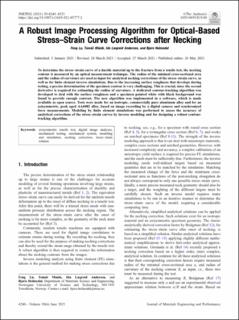| dc.contributor.author | Lu, Feng | |
| dc.contributor.author | Manik, Tomas | |
| dc.contributor.author | Andersen, Ida Lægreid | |
| dc.contributor.author | Holmedal, Bjørn | |
| dc.date.accessioned | 2022-02-09T08:26:45Z | |
| dc.date.available | 2022-02-09T08:26:45Z | |
| dc.date.created | 2021-12-08T10:30:47Z | |
| dc.date.issued | 2021 | |
| dc.identifier.citation | Journal of materials engineering and performance. 2021, 30 (6), 4240-4253. | en_US |
| dc.identifier.issn | 1059-9495 | |
| dc.identifier.uri | https://hdl.handle.net/11250/2977875 | |
| dc.description.abstract | To determine the stress–strain curve of a ductile material up to the fracture from a tensile test, the necking contour is measured by an optical measurement technique. The radius of the minimal cross-sectional area and the radius of curvature are used as input for analytical necking corrections of the stress–strain curve, as well as for finite element inverse simulations. Due to the increasing surface roughness that develops during testing, a precise determination of the specimen contour is very challenging. This is crucial, since the second derivative is required for estimating the radius of curvature. A dedicated contour-tracking algorithm was developed to deal with the surface roughness and a specimen painted white with black background was found to provide enough contrast. The new algorithm was implemented in a software, which is made available as open source. Tests were made for an isotropic, commercially pure aluminum alloy and for an axisymmetric, peak aged AA6082 alloy, based on image recording by a digital camera and synchronized force measurements. Modeling by finite element simulations was performed to assess the accuracy of analytical corrections of the stress–strain curves by inverse modeling and for designing a robust contour-tracking algorithm. | en_US |
| dc.language.iso | eng | en_US |
| dc.publisher | Springer Nature | en_US |
| dc.rights | Navngivelse 4.0 Internasjonal | * |
| dc.rights.uri | http://creativecommons.org/licenses/by/4.0/deed.no | * |
| dc.title | A Robust Image Processing Algorithm for Optical-Based Stress–Strain Curve Corrections after Necking | en_US |
| dc.type | Peer reviewed | en_US |
| dc.type | Journal article | en_US |
| dc.description.version | publishedVersion | en_US |
| dc.source.pagenumber | 4240-4253 | en_US |
| dc.source.volume | 30 | en_US |
| dc.source.journal | Journal of materials engineering and performance | en_US |
| dc.source.issue | 6 | en_US |
| dc.identifier.doi | 10.1007/s11665-021-05777-2 | |
| dc.identifier.cristin | 1966016 | |
| cristin.ispublished | true | |
| cristin.fulltext | original | |
| cristin.qualitycode | 1 | |

